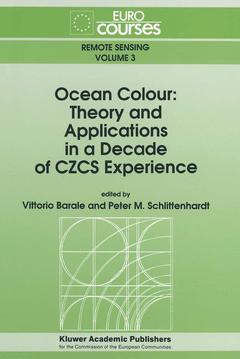Description
Ocean Colour: Theory and Applications in a Decade of CZCS Experience, Softcover reprint of the original 1st ed. 1993
Eurocourses: Remote Sensing Series, Vol. 3
Coordinators: Barale Vittorio, Schlittenhardt Peter M.
Language: English
Keywords
Coast; Ocean; Oceanography; marine; plankton; remote sensing; satellite; sensors; remote sensing/photogrammetry
Publication date: 11-2012
369 p. · 16x24 cm · Paperback
369 p. · 16x24 cm · Paperback
Description
/li>Contents
/li>
Optical remote sensing is of invaluable help in understanding the marine environment and its biogeochemical and physical processes. The Coastal Zone Color Scanner (CZCS), which operated on board the Nimbus-7 satellite from late 1978 to early 1986, has been the main source of ocean colour data. Much work has been devoted to CZCS data processing and analysis techniques throughout the 1980s. After a decade of experience, the Productivity of the Global Ocean (PGO) Activity - which was established in the framework of the International Space Year 1992 (ISY '92) by SAFISY, the Space Agency Forum of ISY - sponsored a workshop aimed at providing a reference in ocean colour science and at promoting the full exploitation of the CZCS historical data in the field of biological oceanography. The present volume comprises a series of state-of-the-art contributions on theory, applications and future perspectives of ocean colour. After an introduction on the historical perspective of ocean colour, a number of articles are devoted to the CZCS theoretical background, on radiative transfer and in-water topics, as well as on calibration, atmospheric correction and pigment concentration retrieval algorithms developed for the CZCS. Further, a review is given of major applications of CZCS data around the world, carried out in the past decade. The following part of the book is centered on the application of ocean colour to the assessment of marine biological information, with particular regard to plankton biomass, primary productivity and the coupling of physical/biological models. The links between global oceanic production and climate dynamics are also addressed. Finally, the last section is devoted to future approaches and goals of ocean colour science, and to planned sensors and systems. The book is required reading for those involved in ocean colour and related disciplines, providing an overview of the current status in this field as well as stimulating the debate on new ideas and developments for upcoming ocean colour missions.
Preface. 1. Optical Remote Sensing of the Oceans: BC (before CZCS) and AC (after CZCS); R.W. Austin. 2. CZCS: Its Role in the Study of the Growth of Oceanic Phytoplankton; C.S. Yentsch. 3. Radiative Transfer in the Atmosphere for Correction of Ocean Color Remote Sensors: H.R. Gordon. 4. Underwater Light Field and Primary Production: Application to Remote Sensing; S. Sathyendranath, T. Platt. 5. CZCS Data Processing Algorithms; B. Sturm. 6. The Coastal Zone Color Scanner (CZCS) Algorithm, a Critical Review of Residual Problems; J.J. Simpson. 7. Review of the Major CZCS Applications: U.S. Case Studies; C.R. McClain. 8. Ocean Colour and CZCS Applications in and around Europe; V. Barale, R. Doerffer. 9. Special Features and Applications of CZCS Data in Asian Waters; H. Fukushima, J. Ishizaka. 10. Global Oceanic Production and Climate Change; G.P. Harris, G.C. Feldman, F.B. Griffiths.. 11. Coupling of Ocean Color Data to Physical-Biological Models; J. Ishizaka, E.E. Hofmann. 12. Ocean Colour in relation to Biological Patterns and Processes in a Biogeographical Province; J. Peláez-Hudlet. 13. Seasonal and Meridional Variability of the Remotely Sensed Fraction of Euphotic Zone Chlorophyll Predicted by a Lagrangian Plankton Model; K.U. Wolf, V. Strass. 14. Future Systems for Global Monitoring of Ocean Colour; H. Van der Piepen, R. Doerffer. Subject Index.
© 2024 LAVOISIER S.A.S.




